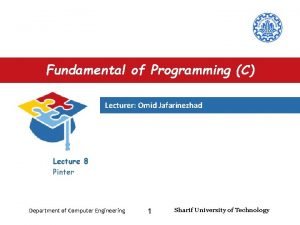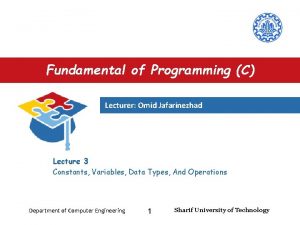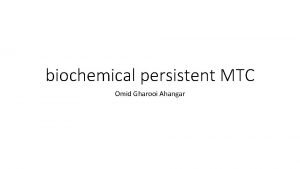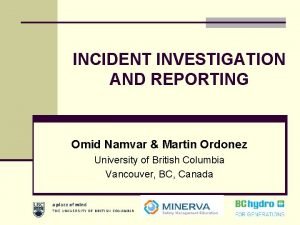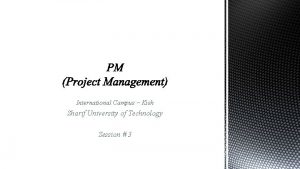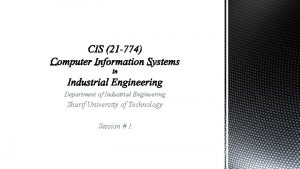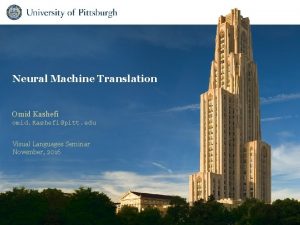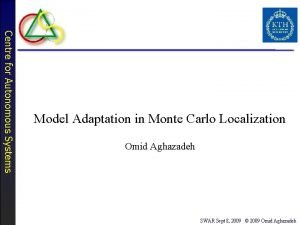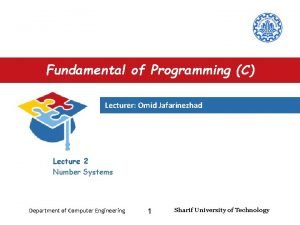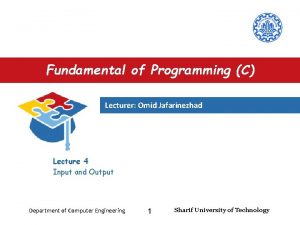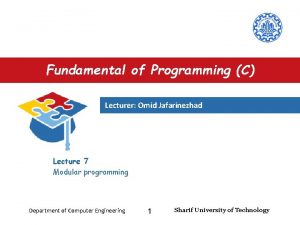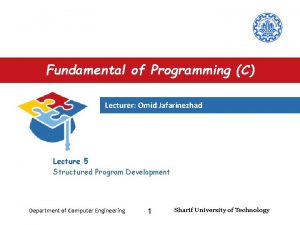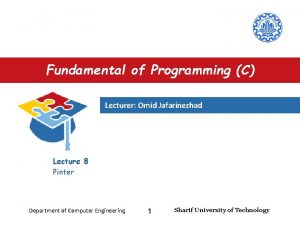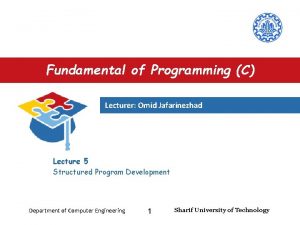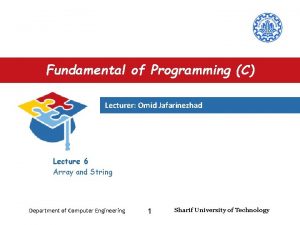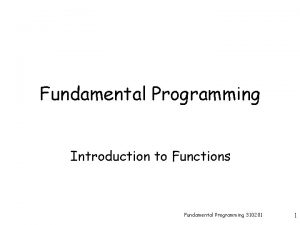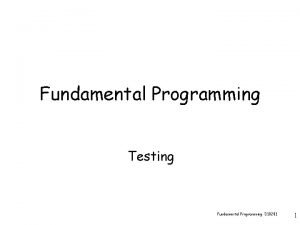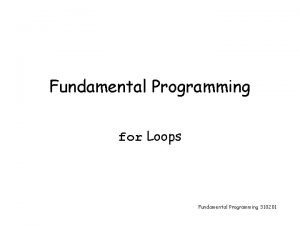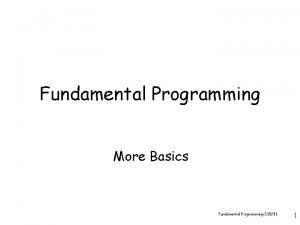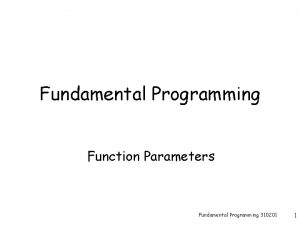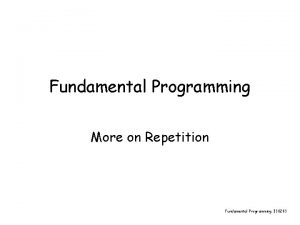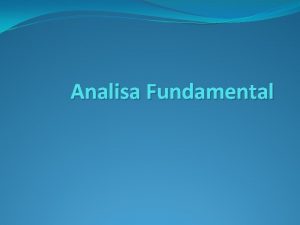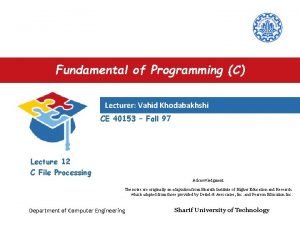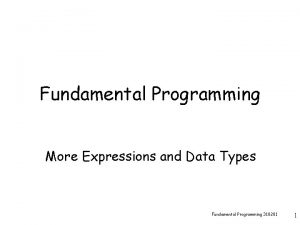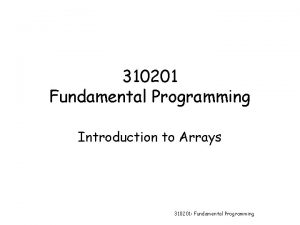Fundamental of Programming C Lecturer Omid Jafarinezhad Lecture


































- Slides: 34

Fundamental of Programming (C) Lecturer: Omid Jafarinezhad Lecture 2 Number Systems Department of Computer Engineering 1 Sharif University of Technology

Number Systems – Lecture 2 Outline • • Numeral Systems Computer Data Storage Units Numeral Systems Conversion Calculations in Number Systems Signed Integer Representation Fractional and Real Numbers ASCII Codes Department of Computer Engineering 2 Sharif University of Technology

Number Systems – Lecture 2 Numeral Systems • Decimal number system (base 10) • Binary number system (base 2) – Computers are built using digital circuits – Inputs and outputs can have only two values: 0 and 1 • 1 or True (high voltage) • 0 or false (low voltage) – Writing out a binary number such as 1001001101 is tedious, and prone to errors • Octal and hex are a convenient way to represent binary numbers, as used by computers – Octal number system (base 8) – Hexadecimal number system (base 16) Department of Computer Engineering 3 Sharif University of Technology

Number Systems – Lecture 2 Numeral Systems Base B : 0 ≤ digit ≤ B -1 ----------------------Base 10 : 0 ≤ digit ≤ 9 (10 -1) Base 2 : 0 ≤ digit ≤ 1 (2 -1) Base 8 : 0 ≤ digit ≤ 7 (8 -1) Base 16 : 0 ≤ digit ≤ 15 (16 -1) Decimal Binary Octal Hexadecimal 0 0 1 1 2 2 2 3 3 3 4 4 4 5 5 5 6 6 6 7 7 7 8 8 9 9 A (decimal value of 10) B (decimal value of 11) C (decimal value of 12) D (decimal value of 13) E (decimal value of 14) F (decimal value of 15) Department of Computer Engineering 4 Sharif University of Technology

Number Systems – Lecture 2 Computer Data Storage Units • Bit 0 OR 1 – Each bit can only have a binary digit value: 1 or 0 – basic capacity of information in computer – A single bit must represent one of two states: 21=2 • How many state can encode by N bit? Department of Computer Engineering 5 Sharif University of Technology

Number Systems – Lecture 2 Binary Encoding 2 1 0 0 1 0 2 1 0 0 0 1 2 0 0 1 0 3 0 0 1 1 4 0 1 0 0 5 0 1 6 0 1 1 0 7 0 1 1 1 8 1 0 0 0 9 1 0 0 0 0 1 2 0 1 0 3 0 1 1 10 1 0 11 1 0 1 1 12 1 1 0 0 13 1 1 0 1 14 1 1 1 0 15 1 1 0 0 0 4 1 0 0 1 5 1 0 0 2 1 0 6 1 1 0 1 1 3 1 1 7 1 1 1 Department of Computer Engineering 3 6 Sharif University of Technology

Number Systems – Lecture 2 Computer Data Storage Units • Byte: A sequence of eight bits or binary digits – 28 = 256 (0. . 255) – smallest addressable memory unit 7 6 5 4 3 2 1 0 Bit Order 0 0 0 0 0 One Bit 1 0 0 0 0 1 2 0 0 0 1 0 3 3 0 0 0 1 1 … … … … … Address Memory 0 1 2 Department of Computer Engineering 7 Sharif University of Technology

Number Systems – Lecture 2 Computer Data Storage Units • Kilo byte: 2 10 = 1024 – 2 11 = 2 K = 2048 – 2 16 = 64 K = 65536 • Mega byte: 2 20 = 1024 × 1024 – 2 21 = 2 M • Giga byte: 2 30 Department of Computer Engineering 8 Sharif University of Technology

Number Systems – Lecture 2 Numeral Systems Conversion • Covert from Base-B to Base-10: – (A) B = (? ) 10 • • (4173)10 = (4173)10 (11001011. 0101)2 = (? )10 (0756)8 = (? )10 (3 b 2)16 = (? )10 • Convert from Base-10 to Base-B: – (N) 10 = (? ) B • (4173) 10 = (? )2 • (494) 10 = (? )8 • (946) 10 = (? )16 Department of Computer Engineering 9 Sharif University of Technology

Number Systems – Lecture 2 Covert from Base-B to Base-10 1. Define bit order. . 7 6 5 4 3 2 1 0 1 - 2 - 3 - . . • Example : Base-2 to Base-10 7 6 5 4 3 2 1 0 1 1 0 0 1 1 Department of Computer Engineering 10 . 1 - 2 - 3 - -4 0 1 Sharif University of Technology

Number Systems – Lecture 2 Covert from Base-B to Base-10 2. Calculate Position Weight – B bit order Decimal Point 102 101 100 10 -1 10 -2 100 s 1 s 1/100 s 9 8 7 5 6 . • Example : Base-2 to Base-10 Position Weight … B=2 27 26 25 24 23 22 21 20 21 - 2 -2 2 -3 2 -4 7 6 5 4 3 2 1 0 1 - 2 - 3 - -4 1 1 0 0 1 1 0 1 Department of Computer Engineering 11 . Sharif University of Technology

* Number Systems – Lecture 2 Covert from Base-B to Base-10 3. Multiplies the value of each digit by the value of its position weight 128 64 32 16 8 4 2 1 0. 5 0. 25 0. 125 0. 0625 7 6 5 4 3 2 1 0 1 - 2 - 3 - -4 1 1 0 0 1 0 1 127 * 1 64 * 1 32 * 0 16 * 0 8 * 1 4 * 0 2 * 1 1 * 1 0. 5 * 0 0. 25 * 1 128 64 0 0 8 0 2 1 0 0. 25 Department of Computer Engineering 12 . . 0. 125 0. 0625 * * 0 1 0 0. 0625 Sharif University of Technology

Number Systems – Lecture 2 Covert from Base-B to Base-10 4. Adds the results of each section 128 64 32 16 8 4 2 1 0. 5 0. 25 0. 125 0. 0625 7 6 5 4 3 2 1 0 1 - 2 - 3 - -4 1 1 0 0 1 0 1 128 * 1 64 * 1 32 * 0 16 * 0 8 * 1 4 * 0 2 * 1 1 * 1 0. 125 * 0 0. 0625 * 1 128 64 0 0 8 0 2 1 0 0. 0625 203. 3125 203 Department of Computer Engineering . 0. 5* 0. 25 0 * 1. + 13 0 0. 25 0. 3125 Sharif University of Technology

Number Systems – Lecture 2 Covert from Base-B to Base-10 • Examples: (a n-1 a n-2 … a 0. a -1 … a -m ) B = (N)10 N = (a n-1 * B n-1) + (a n-2 * B n-2) + … + (a 0 * B 0) + (a -1 * B -1) + … + (a -m * B –m) • • (4173)10 = (4 * 103) + (1 * 102) + (7*101) + (3*100) = (4173)10 (0756)8 = (0 * 83) + (7 * 82) + (5*81) + (6*80) = (494)10 (3 b 2)16 = (3 * 162) + (11*161) + (2*160) = (946)10 (2 E 6. A 3)16 = (2 * 162) + (14*161) + (6*160) + (10 * (1 / 16)) + (3 * (1 / (16 * 16))) = (? )10 16 -1 Department of Computer Engineering 16 -2 14 Sharif University of Technology

Number Systems – Lecture 2 Convert from Base-10 to Base-B • (N)10 = ( a n-1 a n-2 … a 0 . a -1 … a -m ) B Integer part Fraction part 1. Convert integer part to Base-B – Consecutive divisions 25. 125 2. Convert fraction part to Base-B – Consecutive multiplication Department of Computer Engineering 15 25 0. 125 Sharif University of Technology

Number Systems – Lecture 2 Convert Integer Part to Base-B • Repeat until the quotient reaches 0 • Write the reminders in the reverse order – Last to first • Examples: 25 2 24 12 2 1 12 6 2 0 6 3 2 0 2 1 0 0 ( 25 )10 = (11001) 2 1 Department of Computer Engineering 16 Sharif University of Technology

Number Systems – Lecture 2 Convert Integer Part to Base-B • Examples: 494 8 488 61 8 6 56 7 8 5 0 0 16 944 59 16 2 48 3 16 11 0 0 3 7 (946)10 = (3 B 2)16 (494)10 = (756)8 Department of Computer Engineering 946 17 Sharif University of Technology

Number Systems – Lecture 2 Convert Fraction Part to Base-B • Do • multiply fraction part by B (the result) • drop the integer part of the result (new fraction) • While • (result = 0) OR (reach to specific precision) • the integral parts from top to bottom are arranged from left to right after the decimal point Department of Computer Engineering 18 Sharif University of Technology

Number Systems – Lecture 2 Convert Fraction Part to Base-B • Example: – 0. 125 * 2 = 0. 25 – 0. 25 * 2 = 0. 50 (0. 125)10 = (0. 001)2 – 0. 50 * 2 = 1. 00 – 0. 00 * 2 = 0. 00 Department of Computer Engineering 19 Sharif University of Technology

Number Systems – Lecture 2 Convert Fraction Part to Base-B • Example: – 0. 6 * 2 = 1. 2 – 0. 2 * 2 = 0. 4 (0. 6)10 = (0. 1001)2 – 0. 4 * 2 = 0. 8 – 0. 8 * 2 = 1. 6 – 0. 6 * 2 = … Department of Computer Engineering 20 Sharif University of Technology

Number Systems – Lecture 2 Conversion binary and octal • Binary to Octal Binary 0 000 1 001 2 010 3 011 4 100 5 101 6 110 7 111 – 23 = 8 – Each digit in octal format: 3 digits in binary format – If the number of digits is not dividable by 3, additional zeros: 0 a 3 a 2 a 1 a 0 . a-1 a-2 • 43 = 000043 = 043. 000 • (10011. 1101) 2 = (010011. 110100) 2 = (23. 64) 8 2 3 6 4 Department of Computer Engineering 21 Sharif University of Technology

Number Systems – Lecture 2 Conversion binary and octal • Octal to Binary – Substitute each digit with 3 binary digits • • (5)8 = (101)2 (1)8 = (001)2 (51)8 = (101 001)2 (23. 61) 8 = (010 011. 110 001) 2 Department of Computer Engineering 22 Sharif University of Technology

Number Systems – Lecture 2 Conversion binary and Hexadecimal • Binary to Hexadecimal – 24 = 16 – Each digit in octal format: 4 digits in binary format – If the number of digits is not dividable by 4, additional zeros: 0 a a a 3 2 1 0 . -1 -2 • (1111101. 0110) 16 = (01111101. 0110) 16 = (7 D. 6) 2 7 D 6 Department of Computer Engineering 23 Sharif University of Technology

Number Systems – Lecture 2 Conversion binary and Hexadecimal • Hexadecimal to Binary – Substitute each digit with 4 binary digits • (F 25. 03) 16 = (1111 0010 0101. 0000 0011) 2 1111 0010 0101. 0000 0011 Department of Computer Engineering 24 Sharif University of Technology

Number Systems – Lecture 2 Conversion • Octal binary Hexadecimal – (345) 8 = (E 5) 16 – (345) 8 = (011100101) 2 = (E 5) 16 3 4 5 E 5 – (3 FA 5) 16 = (0011111110100101) 2 = (0011111110100101) 2 = (037645) 8 = (37645) 8 Department of Computer Engineering 25 Sharif University of Technology

Number Systems – Lecture 2 Calculations in Numeral Systems • Addition – Binary 1 (1 + 1 ) 10 → (2) 10 = (10) 2 1 1 1 0 0 1 0 1 1 0 carried digits (13)10 1 1 + 1 → 1 0 (23)10 1 1 1 1 + 1 → 1 1 (36)10 1 0 0 Department of Computer Engineering 26 Sharif University of Technology

Number Systems – Lecture 2 Calculations in Numeral Systems • Addition – Hexadecimal 1 1 7 8 4 4 5 6 7 8 4 B DA B D A 1 B 5 E (8 + D ) 16 → (8 + 13) 10 = (21) 2 = (15) 16 – Octal 1 1 1 7 7 7 1 4 (4 + 6 ) 10 → (10) 10 = (12) 8 7 6 1 0 Department of Computer Engineering 0 0 1 2 27 Sharif University of Technology

Number Systems – Lecture 2 Calculations in Numeral Systems • Subtraction Borrowed digit – Binary (2) 10 = (10) 2 1 1 0 0 1 1 0 2 0 0 2 Borrowed digits (13)10 1 1 0 1 (7)10 1 1 1 (6)10 0 1 1 0 Department of Computer Engineering 28 Sharif University of Technology

Number Systems – Lecture 2 Calculations in Numeral Systems • subtraction – Hexadecimal – Octal 16 + 0 = 16 16 + 3 = 19 2 0 3 5 + 16 =21 3 1 4 5 1 9 7 6 1 7 C F 3 6+ 8 = 14 4 6 7 3 7 Department of Computer Engineering 29 Sharif University of Technology

Number Systems – Lecture 2 Signed Integer Representation • Negative numbers must be encode in binary number systems • Well-known methods – Sign-magnitude – One’s Complement – Two’s Complement • Which one is better? – Calculation speed – Complexity of the computation circuit Department of Computer Engineering 30 Sharif University of Technology

Number Systems – Lecture 2 Sign-magnitude • One sign bit + magnitude bits – – 7 Positive: s = 0 Negative: s= 1 Range = {(-127)10. . (+127) 10} Two ways to represent zero: 6 5 4 3 2 1 0 s Sign Magnitude • 0000 (+0) • 10000000 (− 0) – Examples: • (+ 43)10 = 00101011 • (- 43)10 = 10101011 • How many positive and negative integers can be represented using N bits? – Positive: 2 N-1 - 1 – Negative: 2 N-1 - 1 Department of Computer Engineering 31 Sharif University of Technology

Number Systems – Lecture 2 Two’s Complement • Negative numbers: 1. 2. • • Invert all the bits through the number ~(0) = 1 ~(1) = 0 Add one -1 1 1 1 1 -2 1 1 1 1 0 1 Example: Negative • +1 = 00000001 • - 1 = ? – ~(00000001) → 11111110 – 11111110 + 1 → 1111 two's complement (11111101) ~(11111101) + 1 • Only one zero (0000) -(00000011) = -3 • Range = {127. . − 128} Department of Computer Engineering 32 Sharif University of Technology

Number Systems – Lecture 2 ASCII Codes • American Standard Code for Information Interchange – First decision: 7 bits for representation – Final decision: 8 bits for representation • 256 characters • ASCII (“P”) = (50) 16 ASCII (“=”) = (3 D) 16 row number column number Hexadecimal 0 1 2 3 4 5 6 7 0 NUL DLE 0 @ P ` p 1 2 3 4 5 6 7 8 9 A B SOH STX EOT ENQ ACK BEL BS TAB LF VT DC 1 DC 2 DC 3 DC 4 NAK SYN ETB CAN EM SUB ESC ! " # $ % & ' ) ( * + 1 2 3 4 5 6 7 8 9 : ; A B C D E F G H I J K Q R S T U V W X Y Z ] a b c d e f g h i j k q r s t u v w x y z } Department of Computer Engineering 33 C FF FS , > L l | D CR GS = M [ m { E SO RS. < N ^ n ~ F SI US / ? O _ o Sharif University of Technology

Number Systems – Lecture 2 Summary • Numeral Systems – Decimal, Binary, Octal, Hexadecimal • Computer Data Storage Units – Bit, Byte, Kilo byte, Giga byte, • Numeral Systems Conversion – Convert between different bases • Calculations in Number Systems – Addition and subtraction • Signed Integer Representation – Sing-magnitude: one sign bit + magnitude bits – Two’s complement : (-N) = ~(N) + 1 • Fractional and Real Numbers • ASCII Codes Department of Computer Engineering 34 Sharif University of Technology
 Omid jafarinezhad
Omid jafarinezhad Omid jafarinezhad
Omid jafarinezhad Lecturer's name or lecturer name
Lecturer's name or lecturer name 01:640:244 lecture notes - lecture 15: plat, idah, farad
01:640:244 lecture notes - lecture 15: plat, idah, farad Pearson lecturer resources
Pearson lecturer resources Cfa lecturer handbook
Cfa lecturer handbook Good afternoon my dear students
Good afternoon my dear students Designation of lecturer
Designation of lecturer Spe distinguished lecturer
Spe distinguished lecturer Lecturer asad ali
Lecturer asad ali Photography lecturer
Photography lecturer Gcwak
Gcwak Jeannie watkins
Jeannie watkins Lector vs lecturer
Lector vs lecturer Lecturer in charge
Lecturer in charge Lecturer name
Lecturer name Spe distinguished lecturer
Spe distinguished lecturer Lecturer in charge
Lecturer in charge Designation lecturer
Designation lecturer Omid ahangar
Omid ahangar Omid asadi artist
Omid asadi artist Martin ordonez
Martin ordonez Omid fatahi valilai
Omid fatahi valilai Omid fatahi valilai
Omid fatahi valilai Omid mirmotahari
Omid mirmotahari Omid parhizkar
Omid parhizkar Omid mirmotahari
Omid mirmotahari Omid kashefi
Omid kashefi Omid aghazadeh
Omid aghazadeh Omid askari
Omid askari C data types with examples
C data types with examples Integer programming vs linear programming
Integer programming vs linear programming Perbedaan linear programming dan integer programming
Perbedaan linear programming dan integer programming Programing adalah
Programing adalah Greedy vs dynamic
Greedy vs dynamic
